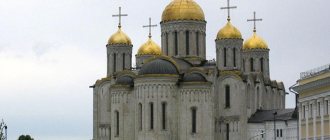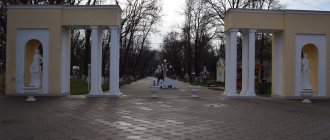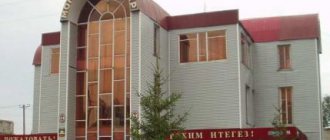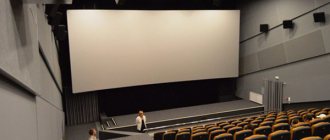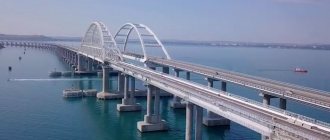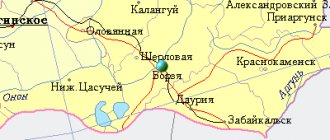Zaprudnya is an urban-type settlement in the Taldomsky district of the Moscow region on the Moscow Canal. PGT status was obtained in 1932, although the settlement has been known as a large village since 1627. Today the population of the village is 12.6 thousand people.
In 1860, a small glass factory was established in the village of Zaprudnya. Over more than 100 years, it has grown into the largest enterprise - a plant of electric vacuum devices.
The coat of arms of the village of Zaprudnya was approved on November 1, 1988 by decision No. 145 of the executive committee of the Zaprudninsky village Council of People's Deputies of the Taldom district of the Moscow region. The authors of the coat of arms are Yuri and Konstantin Mochenov.
The coat of arms is presented in the form of a shield with a blue tip, completed by a black stripe depicting an earthen dam, which indicates the name of the village. In the golden field there is a stylized image of a television screen, dissected in 3 colors, which shows the leading enterprise of the village - the Zaprudninsky Electric Vacuum Devices Plant, which produces picture tubes for televisions. The golden color of the field reflects the sand, the raw material for making glass. The colors of the screen reflect: blue - the fact that the Moscow Canal passes near the village; red - glorious labor and revolutionary traditions of local residents; green - the surrounding area of the village, rich in forests and meadows. The stylized image of the golden tower of the Moscow Kremlin in the red field of the screen reflects the fact that the village is located in the Moscow region.
The village consists of 3 microdistricts. The main, central part is located on the right bank of the Moscow Canal between the A-104 Moscow - Dubna highway and the old Taldomskaya road passing through the village of Tanino. In this part is the administrative center of the village, in the vicinity of which multi-storey buildings predominate. In the rest of Zaprudnya, the houses are mostly wooden, one-story, including in the areas of Gari and Khokhlovo, adjacent to the north, and Pervomaiskaya Street, connecting the center with the platform. A small river, Kunovka, flows through the center of the village. Here, in the center, one of the largest electric vacuum plants in the former USSR is located. On the outskirts of the central part of the village there is the Zaprudnya railway platform. Another microdistrict of Zaprudny is located on the left bank of the Moscow Canal near the Competition pier. This is a small village - Leskhoz - with wooden buildings. Today, due to the closure of the ferry across the canal, this microdistrict is almost completely cut off from the main village. The last part of Zaprudnya is located 3 kilometers south of the central part of the village near the “Competition” railway station.
The landscape of the region was formed as a result of continental icing (Valdai), traces of which are in the form of pebble deposits, boulders, etc. can be found even now. Zaprudnya is located on the Volga-Dubna lowland. To the south, in the Dmitrovsky district, the Smolensk-Moscow Upland begins (the Klinsko-Dmitrovskaya ridge is the highest part of the Moscow region).
City `s history
Zaprudnya is located one hundred kilometers north of Moscow and has a long history.
The dam arose on the bank of the Kunovka River, near a dam that formed a small lake. At that time, Zaprudnya was located away from large settlements and roads. The nearest district town of Dmitrov was 30 versts away, and even the Savelovskaya railway, built at the end of the 19th century, passed through Verbilki, 15 versts from Zaprudnya. The situation changed in the middle of the 20th century, when the Moscow-Volga canal route passed not far from Zaprudnya. A highway was built along the canal, which runs near the outskirts of the village. After the war, at the end of the 40s, the construction of the Institute of Nuclear Research and the city of Dubna began, and at the same time the railway laid during the construction of the canal was restored. A small glass guta, founded in 1860 by a peasant from the village of Zaprudnaya, Fadey Timofeev, grew over a century and a half into a large industrial enterprise, and the former village grew along with it, successively including the village of Gari, the village of Khokhlovo, and the village of Competition within its borders.
The village of Zaprudnya was first mentioned in the “Scribe Books” of Dmitrovsky District 377 years ago. Then it was also known as Morevskoye. As for the main name - Zaprudnaya, by which the village was later known, its origin can be explained very simply - from the phrase “beyond the pond”. This newspeak directly testifies to the close connection of the village of Zaprudnya with the neighboring village of Gari, from which it was indeed separated only by a pond.
The village of Gari was also mentioned in the Scribe Books of 1627, but not for the first time. Thus, in the exchange “letter” of the Dmitrov prince Yuri Ivanovich and the abbot of the Trinity-Sergius Monastery, dated January 20, 1506 (!), among the exchanged wives (mowing) the “reap of Obrosimkov Ignatov’s son from Garey” is mentioned. Thus, while celebrating its 377th anniversary today, Zaprudnya has the right to celebrate its 500th anniversary in a couple of years.
The ancient village has changed many owners over the centuries. It belonged to the steward of His Holiness Patriarch N.F. Leontyev, given to his father Fyodor Leontyev by Tsar Vasily Shuisky in 1610 “for sitting under siege” during the period of the Polish intervention. Later, the village was owned by the princes Shcherbatovs, Counts Golovkins and Shuvalovs, and landowner A.F. Cheredeeva. The latter owned the village of Gari and surrounding villages during the critical period of their existence - at the turn of the 1860s.
Let’s look through the “List of populated places in the Moscow province according to information from 1859.” In the village of Gari there are 52 households with a population of 343 people and a church in the name of the Transfiguration of the Lord, known at least since 1629; in the village of Zaprudnaya there are 21 yards and 186 inhabitants; in the village of Khokhlovka (Khokhlova) there are 11 households and 78 inhabitants. Russia is actively preparing for the introduction of peasant reform. Landowners are cutting back on peasant plots, hoping to set the peasants free and without any land at all.
The most educated farmers think about the coming changes in advance. This is where the former headman of a rural community, peasant Fadey Timofeev, appears on the pages of history, who decided to brighten up his landless existence by having a handicraft factory of glass products. No sooner said than done, but it was not yet time for the peasants to argue with the landowners and merchants: the factory quickly changed owners, being sold along with 125 acres of land to the merchant P.I. Lytnev. However, Fadey Timofeev’s glass idea fell on fertile ground. Since then, no matter how the owners of glass production changed, it only expanded and multiplied.
In 1860, the factory consisted of only one furnace, which was used by its owner to make apothecary glassware. And then there was everything: elegant bottles for exquisite French perfumes, medical flasks, retorts, light bulbs...
In 1914, Isaac Ilyich Kitaygorodsky (who later became a world-famous scientist) was able to organize the production of domestic electric lamp glass at the enterprise. The Zaprudnensky plant becomes a monopolist in this type of product and remains the leader in its industry for many years.
Its owners, and later the directors, knew no rest, they were always looking for something, rebuilding, updating. During the war, they left the place and left for distant Siberia. The situation changed in the late 50s. At that time, the electronics industry began to develop rapidly in the Soviet Union, and it was decided to create a plant for the production of picture tubes on the basis of the Zaprudnensky Glass Factory. The Zaprudnensky plant was transferred to the Ministry of Electronic Industry, and houses began to be built at the plant - first two-three-story, then five-story, and in the mid-80s - nine-story houses. In 1967, for the 50th anniversary of the revolution, a three-story village administration building was built. The vocational school located on the outskirts of the village was repurposed to train personnel for the plant. They built a hospital, kindergartens, and schools. By the mid-80s, 17 thousand people lived in the village - the same as in the regional center of Taldom.
The plant grew in breadth and height, and along with it the village became prettier. And no one imagined that at the end of the twentieth century the Russian economy would fail so seriously that the products of domestic radio electronics would be unclaimed. That villages focused on city-forming enterprises will have a much more difficult time surviving than everyone else. Alas, that’s what happened. Today, a considerable number of Zaprudny residents go to work in nearby Moscow every day. The plant is going through difficult times, and this circumstance does not add to the beauty of Zaprudnya. The only thing that cannot be taken away from Russians is natural optimism.
In this photo you can see what the village church looked like in the past. It was destroyed, like most others in the distant fifties, by order of the party, and the bricks from which it was built were used to build livestock buildings. Elderly residents of Zaprudnaya recall that when the church was broken, the believers cried and behind their backs asked God to punish the atheists. We don’t know if this is true, but they say that many participants in those events paid with their health. It is difficult to judge the beauty and size of the building from this photo, but again, according to the stories of old-timers, the village church was one of the largest, most beautiful and richest in the area. They say that when the bells rang, their ringing could be heard even in Novo-Nikolskoye, and from there the domes and crosses of the domes were visible. It’s a pity that there are very few people left who remember and attended services in our church.
The wooden church in the village of Gari (now part of the village of Zaprudnya) was erected in 1701 (according to other sources, even earlier - in the 17th century). Later, a stone church (pictured) grew in its place, where chapels were consecrated in honor of the Transfiguration of the Lord, Epiphany and Intercession. For centuries, the temple nourished the surrounding flock with its services, until the Bolsheviks who came to power closed it in 1933. The last rector, priest Vladimir Speransky, despite the closure of the church, continued to serve, preached on holidays, and received parishioners at home. Wise sermons and a strong civic position could not help but irritate the authorities, and in August 1937, under a flimsy pretext, Fr. Vladimir was arrested, and on October 21, 1937, he was shot at the training ground in Butovo near Moscow. The closed temple was slowly being destroyed. In 1950, one of the managers of the Zaprudnensky glass factory, Yuri Pavlovich Sorokin, became interested in its fate - on his orders, the temple was completely dismantled. The foundation stones were transported to the village of Tanino for the construction of the first brick barn, and the walls were destroyed. Sorokin’s deed resulted in severe illness and blindness, and the site of the destroyed temple is still a wasteland to this day. For more than sixty years, bells had not sounded over Zaprudnya; parishioners traveled to Orudyevo, Zhukovka, and Dmitrov.
Zaprudnya is located one hundred kilometers north of Moscow and has an ancient history. This settlement arose on the banks of the Kunovka River, near a dam that formed a small lake. At that distant time, Zaprudnya was located away from large settlements and roads. The village of Zaprudnya was first mentioned in the “Scribe Books” of Dmitrovsky district in 1506. Then it was also known as Morevskoye. As for the main name – Zaprudnaya, by which the village was later known, its origin can be explained very simply – from the phrase “beyond the pond”. The village of Zaprudnya was indeed separated from the neighboring village of Gari by a pond. The village of Gari was also mentioned in the Scribe Books of 1627, but not for the first time. Thus, in the exchange “letter” of the Dmitrov prince Yuri Ivanovich and the abbot of the Trinity-Sergius Monastery, dated January 20, 1506, among the exchanged wives (mowing) the “reaping of Obrosimkov Ignatov’s son from Garei” is mentioned. The history of Zaprudnya has passed its 500th anniversary. The ancient village has changed many owners over the centuries. It belonged to the steward of His Holiness Patriarch N.F. Leontyev, given to his father Fyodor Leontyev by Tsar Vasily Shuisky in 1610 “for being under siege” during the period of the Polish intervention. Later, the village was owned by the princes Shcherbatovs, Counts Golovkins and Shuvalovs, landowner A.F. Cheredeeva. The last mistress owned the village of Gari and surrounding villages during the critical period of their existence - at the turn of the 1860s. According to the “List of populated places in the Moscow province according to information from 1859,” in the village of Gari there were 52 households with a population of 343 people and a church in the name of the Transfiguration of the Lord, known at least since 1629. In the village of Zaprudnaya there are 21 courtyards and 186 residents, in the village of Khokhlovka (Khokhlova) there are 11 courtyards and 78 residents.
Zaprudnya today
Zaprudnya received the status of an urban-type settlement in 1932. Today the population is 12.6 thousand people. The village consists of three microdistricts. The main, central part is located on the right bank of the Moscow Canal between the A-104 Moscow – Dubna highway and the old Taldom road passing through the village of Tanino. In this part there is the administrative center of the urban settlement, in the vicinity of which multi-storey buildings predominate. In the rest of Zaprudnya, the houses are predominantly wooden, one-story, including in the areas of Gari and Khokhlovo, adjacent to the north, and Pervomaiskaya Street, connecting the center with the platform. A small river, Kunovka, flows through the center of the settlement. Here, in the center, one of the largest electric vacuum plants in the former USSR is located. On the outskirts of the central part of the settlement there is a railway platform “Zaprudnya”. Another microdistrict of Zaprudny is located on the left bank of the Moscow Canal near the “Competition” pier. This is a small village of Leskhoz with wooden buildings. Today, due to the closure of the ferry across the canal, this microdistrict is almost completely cut off from the main village. The last part of Zaprudnya is located three kilometers south of the central part, near the “Competition” railway station.
Former picture tube factory
A city-forming enterprise is the only large enterprise in a locality where the majority of the population works. A settlement can be small, for example, a village, most of whose residents work at a dairy plant, or it can be huge, for example, the city of Norilsk. There was such a city-forming enterprise in the village of Zaprudnya.
Even before the mid-20th century, Zaprudnya was an ordinary village. The main production was agriculture, and also a small pre-revolutionary glass factory producing tableware for local needs. The situation changed at the end of the 50s of the last century. At that time, the electronics industry began to develop rapidly in the Soviet Union, and it was decided to create a plant for the production of picture tubes on the basis of the Zaprudnensky Glass Factory. Picture tubes were also produced in Moscow, but there were not enough of them. And it wouldn’t hurt to have production facilities outside of Moscow in case of war. The Zaprudnensky plant was transferred to the Ministry of Electronic Industry. Rapid construction of infrastructure and multi-apartment residential buildings began. The vocational school located on the outskirts of the village was repurposed to train personnel for the plant. By the mid-80s, 17 thousand people already lived in the village - the same as in the regional center of Taldom. Zaprudny residents joked that the regional center is in Taldom, and not in Zaprudnya, only because there is a monument to Lenin in Taldom.
The main products of the plant were picture tubes of various types - for household televisions, for radars, and for other special equipment. Some of the products were exported. In particular, one line from the early 70s to the mid-80s produced monochrome picture tubes with a diagonal of 40 cm. They were entirely exported under a contract; such picture tubes were not used in the Soviet Union. Serious work for the plant’s specialists was mastering the production of color picture tubes for televisions. For the first time, the production of such picture tubes was mastered in Moscow, and then the technology was transferred to Zaprudnya. But there were also technologies that were first mastered in Zaprudnya. For example, it was in Zaprudny that they first mastered the connection of the screen and the neck of a picture tube using a special vacuum mastic-glue, and not by welding, as was done previously. These were the so-called 61LK4Ts glued picture tubes, which at first the TV experts did not like. Until the technology was fully developed, the mastic allowed air to pass through, and over time, the vacuum in the kinescope deteriorated, which spoiled the image quality. The plant also produced other products, for example, Geiger counters for dosimeters. The plant worked in cooperation with other enterprises. Some components and assemblies were received from other factories, for example, a certain number of electron guns for picture tubes and glass blanks for screens were brought from the Moscow plant. Special trucks for transporting glass blanks constantly plied along Dmitrovskoe Highway. The finished picture tubes went mainly to Alexandrov, to television. Finished products were shipped via railway - a railway line was built from the nearest station Competition to the plant. Some of the picture tubes were supplied to television workshops from all over the Union. On the square in front of the plant there were always cars of “pushers” from television studios from all over the country. The sales department was located in a separate two-story building, and the plant had strict access control. The plant provided work not only to the residents of the village. Specialists traveled to work from Dmitrov and Verbilki. Buses to Dmitrov, Verbilok, Taldom ran once an hour, the stop was located on the square near the factory entrance. Lenin Street also begins from the entrance. The only thing that wasn't very good was the food. Therefore, residents of Zaprudnaya went to Moscow for groceries every weekend. The village was known outside the region. In the 70s, even the traffic police department was not in Dmitrov, but in Zaprudnya, and Dmitrov residents went to Zaprudnya to take driver’s license exams.
The situation changed with the beginning of market reforms. The terrible shortage of domestic televisions in the late 80s gave way to an abundance of imported televisions in the early 90s. The output of domestic television factories has dropped to hundreds of televisions per year throughout the country. Television workshops provided cash, but they could not ensure large sales. The plant was in a fever, and there was not enough money for salaries. The ministry began to receive demands to convert production, and they promised money for this. To get this money, in 1993, under the guise of conversion, the plant dismantled the production line of halogen Geiger counters capable of capturing all types of radioactive radiation. The money received for conversion was used to pay off wage arrears. The collapse began. People left, workshops stopped, supplies of materials - non-ferrous metals - were stolen. As a result, a cottage community of former plant managers appeared on the outskirts of Zaprudnya, and the main production finally stopped. In the mid-90s, the plant management attempted to create a joint venture for the production of picture tubes. SAMSUNG acted as a partner. It was assumed that they would provide money to restore production. The plant was renamed JSC ZELTA, and the joint production was called ZELTA-SAMSUNG. But it didn’t get to production. In the meantime, the premises and territory of the plant were rented out in parts. Shops have settled in the administrative building, which can be entered from the street without a checkpoint. One of the workshops began making glass headlights for cars. In another, the production of cardboard containers was established, but when rent increased, they moved to Klin. In the third workshop, the tenants are going to start assembling furniture. Cigarettes were produced clandestinely in one of the workshops, and this became clear only after the police appeared on the premises. The most massive production at the plant at present is the production of beer bottles for.
There is nowhere in particular to work in the village except at the factory. There are several food stalls and shops, several car services. Small business is not particularly thriving in a village with a population of 16 thousand people. It’s not easy to get a job in a production facility that rents space at a factory—there’s not enough work for everyone. The only way out is to look for work outside the village. But this is not easy either - buses began to run less frequently, once every 2-3 hours. Will another settlement disappear from the map of the Moscow region?
